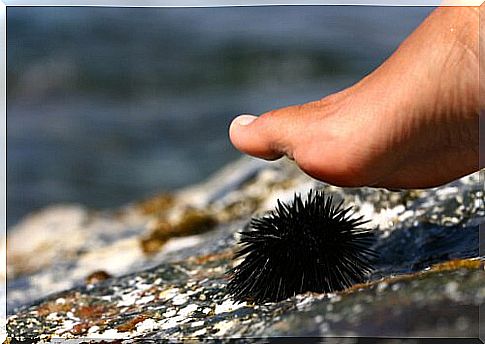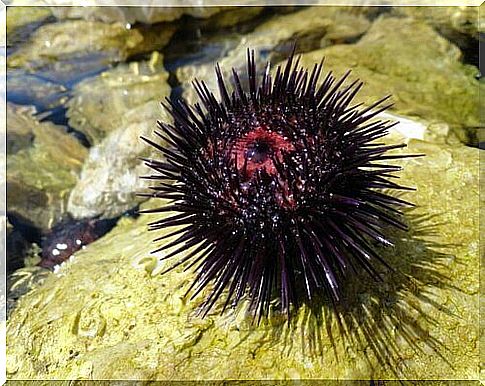How To Respond To A Sea Urchin Sting

We find these animals on the beaches while walking on the sand or even near the shore. These “sponge with thorns” shaped animals can cause a lot of pain and burning with simple contact. That’s why, in the following article, we’ll tell you how you should act when faced with a sea urchin sting.
Sea urchin sting: what to do?
Both in the sea and on the shore or on the rocks, the sea urchins they know how to defend themselves very well against the aggressions they suffer, including those that happen unintentionally. This happens because your body is covered by thick spines that inoculate poisonous substances and cause pain, itching, inflammation and even paralysis muscle.
It is very important to know how to act when faced with a sea urchin sting. This is because, as long as the thorns are not completely removed, they continue to inject poison and aggravate the wound ; the risk of infection is very high.

The steps to follow are:
1. Remove the thorns
This is the most important and urgent thing to prevent the poison keep acting. You can use tweezers, for example. It is necessary to be careful to prevent the thorns from breaking: try to remove them completely. It can help you warm the surrounding skin, and it is always necessary to disinfect any instrument you use with alcohol to prevent infection.
In case they are small or are too deep to remove them with this element, another option is to use wax. Apply a coat of hot wax and wait for it to cool, then quickly pull it off so the thorns stick to it and come off without a hitch.
A third technique includes making a small cut along the side of the spine and pressing down hard so that the skin helps remove this foreign object. It’s like we’re squeezing a blackhead or pimple.
2. Wash the region well
Once you are sure that there are no spikes or thorns left in the skin, the next step is to clean the area with warm water and mild soap or antibacterial soap. This way, you will avoid infection and eliminate all poisonous residue from the sea urchin bite.

3. Do not cover the wound
Dry carefully and apply a few drops of hydrogen peroxide (hydrogen peroxide) or antiseptic. It is very important that you do not cover the wound with a bandage or gauze; allow the skin and pores to “breathe” and finish excreting the substances that were contained in the spines. Also, it’s possible that a thorn hasn’t been removed, and if you cover it, it’ll be easier to get infected or hurt.
4. Rinse the region again
If you notice that the inflammation or the pain doesn’t stop, maybe the sea urchin’s sting was deeper than you thought, or there are still remnants of venom or thorns. An excellent way to alleviate symptoms is to put the area, for example the foot, in a bucket of water as hot as possible.
Keep the wound “upside down” so that, when the pores open because of the pain, whatever is bothering them is released more easily. Some people try adding a few spoonfuls of vinegar or baking soda to the water.
5. Analyze skin changes
To avoid infections, we recommend that you take some type of antibiotic and, to reduce pain, a pain reliever. It is essential to observe the wound and check for any signs of redness, pus or excruciating pain. In this case, consult a doctor as soon as possible.
Signs that may indicate sea urchin sting allergies are hives, trouble breathing, swelling of the lips or tongue, chest pain and reddening of the skin. In these cases, look for an emergency room as soon as possible.









